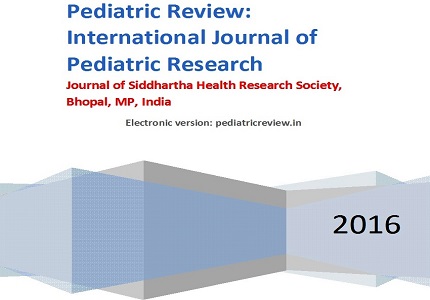A study of Electrocardiographic pattern of normal school children in Palakkad District of Kerala
Abstract
Background: Electrocardiography is a simple, non-invasive and relatively cheap investigative tool used for cardiac evaluation. However, there are limited electrocardiographic studies of Indian children. These differences may also be seen in children, hence, the need to develop local reference values.
Methods: This was a cross-sectional study on selected 450 subjects. An 12 lead ECG was measured on all subjects.
Results: There were two hundred and twenty boys (48.3 %) and two hundred and thirty girls (51.7 %). The mean heart rate decreased with increasing age. R wave amplitudes were higher in the left precordial leads, in keeping with left ventricular dominance. Mean values were higher in males than females in the three age-groups in most of the precordial and limb leads. In V4R, V2, andV3 highest mean R wave voltages of 0.5+0.1 mV, 1.4+0.3 mV and 1.4+0.2 mV were recorded in the 5-7-year-old. While in V5, and V6 the mean R waves were higher in the 12-15-year-old age-group (3.7+ 0.5 mV and 2.5+0.4 mV respectively). The S-Waves showed progressive decrease in its amplitude on the left precordial leads with increasing age.
Conclusion: The mean values in heart rate, QRS duration, PR interval, P wave amplitude showed higher amplitudes in males. Similarly higher amplitudes of R-waves in male children were recorded in precordial leads V2, V3, V5 and V6 in the three age-groups.
Downloads
References
2. Araoye MA. The 12–lead scalar electrocardiogram in negroes. Normal values. Nig Med Pract 1984; 7: 59–65. [PubMed]
3. Araoye MA, Opadijo GO, Omotoso AB. Comparison of scalar with vectorial electrocardiogram in axis determination. West Afr J Med. 1999 Jul-Sep;18(3):187-90. [PubMed]
4. Aroaye MA. Morphological classification of ST-T waveforms in the ECGs of healthy adult Nigerians. WAJM 1983; 117-25. [PubMed]
5. Seriki O, Smith AJ. The electrocardiogram of young Nigerians. Am Heart J. 1966 Aug;72(2):153-7. [PubMed]
6. Edemeka DBU. The electrocardiogram in healthy Nigerian residents in Lagos state. J pure and Applied Sci 2004; 10: 567-70.
7. Ifere OAS. Heart rate, cardiac rhythm and arrhythmia in normal infants and children. Tropical Cardio 1991; 17(66): 61-5.
8. Edemeka DBU, Ojo GO. Electrocardiogram in Nigerian children. Saudi Heart J 1996; 7: 44-8.
9. National High Blood Pressure Education Program Working Group on High Blood Pressure in Children and Adolescents. The fourth report on the diagnosis, evaluation, and treatment of high blood pressure in children and adolescents. Pediatrics 2004; 114:555-76.
10. Davignon A, Rautaharju P, Boiseelle E, Soumis F, Megalas M, Choquette A. Normal ECG standards for infants and children. Pediatr Cardiol 1979; 1:123-52.
11. Ogbeibu AE. Biostatistics. A practical approach to research and data handling. Benin, Nigeria: Mindex; 2005. p. 25-35.
12. Dickson DF. The normal ECG in childhood and adolescence. Heart 2005; 91:1626-30. [PubMed]
13.Rijnbeek PR, Witsenburg M, Schrama E, Hess J, Kors JA. New limits for the paediatric electrocardiogram. Eur Heart J 2001; 22:702-11. [PubMed]
14. Sedat K, Ayhan K, Atilla Ý, Hürkan K, Mustafa KL. P wave duration and P dispersion in healthy children. Turk J Pediatr 2003; 45: 133-5. [PubMed]
15. Sun K, Li F, Zhou Y, Dubin AM, Rautaharju PM, Liebman J, Gregg RE, Helfenbein ED, Lindauer JM, Zhou SH. Normal ECG limits for asian infants and children. Cardiology 2005; 455–8.
16. Macfarlene PW, MacLaughlin SC, Devine B, Yang TF. Effects of age, sex, and race on ECG interval measurements. J Electrocardiol 1994; 27 Suppl: 14-9. [PubMed]

Copyright (c) 2016 Author (s). Published by Siddharth Health Research and Social Welfare Society

This work is licensed under a Creative Commons Attribution 4.0 International License.


 OAI - Open Archives Initiative
OAI - Open Archives Initiative


